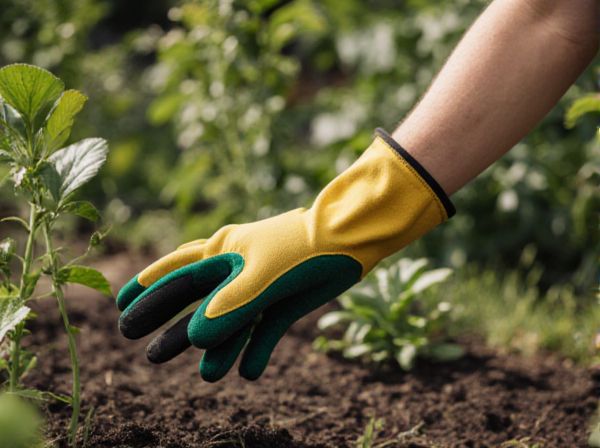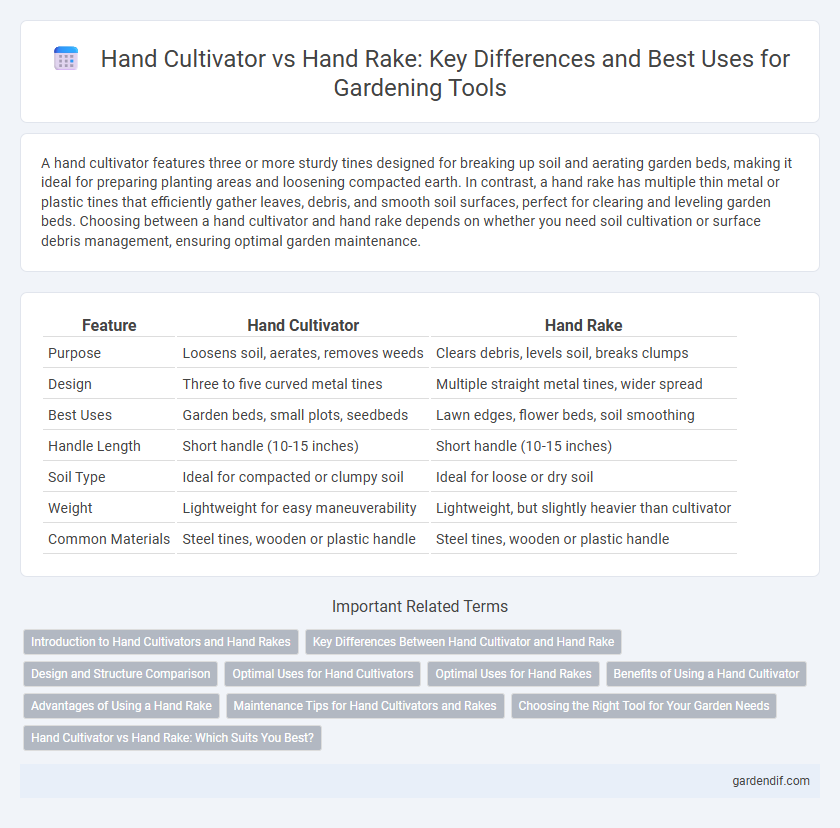
Hand cultivator vs hand rake Illustration
A hand cultivator features three or more sturdy tines designed for breaking up soil and aerating garden beds, making it ideal for preparing planting areas and loosening compacted earth. In contrast, a hand rake has multiple thin metal or plastic tines that efficiently gather leaves, debris, and smooth soil surfaces, perfect for clearing and leveling garden beds. Choosing between a hand cultivator and hand rake depends on whether you need soil cultivation or surface debris management, ensuring optimal garden maintenance.
Table of Comparison
| Feature | Hand Cultivator | Hand Rake |
|---|---|---|
| Purpose | Loosens soil, aerates, removes weeds | Clears debris, levels soil, breaks clumps |
| Design | Three to five curved metal tines | Multiple straight metal tines, wider spread |
| Best Uses | Garden beds, small plots, seedbeds | Lawn edges, flower beds, soil smoothing |
| Handle Length | Short handle (10-15 inches) | Short handle (10-15 inches) |
| Soil Type | Ideal for compacted or clumpy soil | Ideal for loose or dry soil |
| Weight | Lightweight for easy maneuverability | Lightweight, but slightly heavier than cultivator |
| Common Materials | Steel tines, wooden or plastic handle | Steel tines, wooden or plastic handle |
Introduction to Hand Cultivators and Hand Rakes
Hand cultivators are garden tools designed with three to five tines, ideal for loosening soil, aerating bed layers, and removing weeds in small garden spaces. Hand rakes feature multiple flexible metal or plastic tines suitable for leveling soil, gathering leaves, and spreading mulch efficiently. Both tools are essential for maintaining garden health, but their specific functions optimize different soil and surface tasks.
Key Differences Between Hand Cultivator and Hand Rake
A hand cultivator features three to five sturdy tines designed to break up soil and aerate garden beds, promoting root growth and weed control. In contrast, a hand rake has multiple thin metal tines arranged closely, ideal for smoothing soil surfaces and gathering debris or leaves. The primary difference lies in their use: the cultivator loosens soil, while the rake primarily levels and clears garden material.
Design and Structure Comparison
A hand cultivator typically features three to five curved tines designed for loosening soil and aerating small garden beds, offering deeper penetration and better soil turnover. In contrast, a hand rake consists of straight, closely spaced tines ideal for leveling soil, removing debris, and breaking up surface crusts with a flat, fan-shaped design. The structural differences influence their primary functions, with the cultivator's curved tines suited for digging and mixing, while the rake's straight tines excel in smoothing and surface debris clearance.
Optimal Uses for Hand Cultivators
Hand cultivators are ideal for loosening soil, aerating garden beds, and mixing in fertilizer or compost near plants without damaging roots. Their sturdy tines penetrate compacted soil effectively, promoting better root growth and water absorption. Unlike hand rakes, which are better suited for clearing debris and smoothing soil surfaces, hand cultivators excel at targeted soil cultivation in tight spaces.
Optimal Uses for Hand Rakes
Hand rakes excel in loosening soil and removing debris from garden beds, making them ideal for preparing seedbeds and maintaining mulch layers. Their narrow, sturdy tines can reach between plants without damaging roots, providing precise control in tight spaces. Optimal use of hand rakes includes aerating compact soil and clearing weeds, which enhances soil health and promotes plant growth.
Benefits of Using a Hand Cultivator
A hand cultivator offers superior soil aeration and weed control compared to a hand rake, enabling deeper penetration and breaking up compacted earth efficiently. Its three-pronged design promotes healthier root growth by loosening soil without damaging plant roots. This tool also enhances nutrient absorption and water retention, leading to improved garden vitality.
Advantages of Using a Hand Rake
A hand rake offers superior efficiency for clearing debris, loosening soil, and aerating small garden areas compared to a hand cultivator. Its robust tines allow for better control in leveling soil and removing leaves or thatch without damaging delicate plants. The ergonomic design of many hand rakes reduces hand fatigue during extended use, making it ideal for maintaining tidy garden beds and pathways.
Maintenance Tips for Hand Cultivators and Rakes
Regular cleaning of hand cultivators and hand rakes after each use prevents soil buildup and rust, extending tool lifespan. Sharpening the tines of hand cultivators enhances soil penetration, while straightening bent rake tines ensures effective debris collection. Applying a light coat of oil to metal parts protects against corrosion and keeps moving parts functional.
Choosing the Right Tool for Your Garden Needs
Selecting the right garden tool depends on the specific tasks and soil conditions; a hand cultivator features sturdy tines ideal for loosening soil and aerating small garden beds, while a hand rake excels at leveling soil, removing debris, and spreading mulch. For precision work in tight spaces or compacted soil, a hand cultivator provides better control and efficiency, whereas a hand rake suits broader surfaces and cleanup jobs. Evaluating your garden's texture, plant spacing, and maintenance routine ensures choosing between these tools maximizes productivity and care.
Hand Cultivator vs Hand Rake: Which Suits You Best?
A hand cultivator features three to five curved tines designed for loosening soil and aerating roots, making it ideal for garden beds and small vegetable patches. In contrast, a hand rake has multiple straight or slightly curved tines suited for gathering leaves, debris, and smoothing soil surfaces. Choosing between a hand cultivator and hand rake depends on whether your primary task involves soil preparation or surface debris removal.
Hand cultivator vs hand rake Infographic

 gardendif.com
gardendif.com